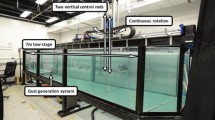Abstract
A novel gust generator was developed to study the interaction of wings with vertical gusts of controllable interaction time with magnitudes up to 30% of the freestream velocity at low Reynolds numbers. This work focuses on the collection of force and flow field data for three airfoils entering vertical gusts. Full-span NACA 0012, Eppler 387, and SD 5060 airfoils were tested with gusts of 20 and 30% of the freestream velocity at a Reynolds number of \(12\times 10^{3}\) and 20% of the freestream at a Reynolds number of \(54.4\times 10^{3}\). The lift generated during the gust interactions showed rapid increases in lift, often with a short-lived overshoot above the steady-state lift at the lower Reynolds number. Accompanying flow field data showed that the overshoot in lift was caused by a reattachment of the flow at the trailing edge of the symmetric NACA 0012, which was observed as a deflection of the streamlines in the freestream flow direction for the cambered airfoils. A new model was created to predict the lift during the interaction, which uses the static lift curve to predict the lift at a given effective flow angle, with corrections to account for the rate of change of the flow angle and camber of the airfoil. This model was able to more accurately predict the lift during gust interactions than the currently used modified Goman–Khrabrov model, while remaining a simple model to implement.















Similar content being viewed by others
References
Aerolab (2012) ARL microsystems aeromechanics wind tunnel owner’s/operator’s manual. Aerolab, 8291 Patuxent Range Rd, Jessup, Maryland 20794 USA
Aerolab (2016) US Army Research Lab Sting Balance Calibration Report. Aerolab, 8291 Patuxent Range Rd, Jessup, Maryland 20794 USA
Bicknell J, Parker A (1972) A wind-tunnel stream oscillation apparatus. J. Aircraft 9(6):446–447. https://doi.org/10.2514/3.59011
Biler H, Jones AR (2020) Force predictions during transverse and vortex gust encounters. Tech. Rep. STO-TR-AVT-282, NATO Science and Technology Organization
Bohrer G, Brandes D, Mandel JT et al (2012) Estimating updraft velocity components over large spatial scales: contrasting migration strategies of golden eagles and turkey vultures. Ecol Lett 15:96–103. https://doi.org/10.1111/j.1461-0248.2011.01713.x
Brion V, Lepage A, Amosse Y et al (2015) Generation of vertical gusts in a transonic wind tunnel. Exp Fluids 56:145. https://doi.org/10.1007/s00348-015-2016-5
Buell DA (1969) An experimental investigation of the velocity fluctations behind oscillating vanes. Tech rep, National Aeronautics and Space Administration
Burgers P, Alexander DE (2012) Normalized lift: An energy interpretation of the lift coefficient simplifies comparisons of the lifting ability of rotating and flapping surfaces. PLoS ONE 7(5). https://doi.org/10.1371/journal.pone.0036732
Cleaver DJ, Wang Z, Gursul I (2013) Investigation of high-lift mechanisms for a flat-plate airfoil undergoing small-amplitude plunging oscillations. AIAA J 51(4):968–980. https://doi.org/10.2514/1.J052213
Cohn RK, Koochesfahani MM (2000) The accuracy of remapping irregularly spaced velocity data onto a regular grid and the computation of vorticity. Exp Fluids 29:S61–S69. https://doi.org/10.1007/S003480070008
Corkery S, Babinsky H, Harvey J (2018) On the development and early observations from a towing tank-based transverse wing-gust encounter test rig. Exp Fluids 59:135. https://doi.org/10.1007/s00348-018-2586-0
Corkery S, Babinsky H, Harvey J (2018b) Response of a flat plate wing to a transverse gust at low reynolds numbers. In: AIAA SciTech Forum, Kissimmee, FL. https://doi.org/10.2514/6.2018-1082
Dabberdt WF, Ludwig FL, Johnson WBJ (1973) Validation and applications of an urban diffusion model for vehicular pollutants. Atmos Environ 7:603–618. https://doi.org/10.1016/0004-6981(73)90019-X
Fernandez F, Cleaver D, Gursul I (2021) Unsteady aerodyamics of a wing in a novel small-amplitude transverse gust generator. Exp Fluids 62(9). https://doi.org/10.1007/s00348-020-03100-8
Figliola RS, Beasley DE (2012) Theory and design for mechanical measurements, 5th edn., chap 5. John Wiley and Sons, New York
Fish F, Lauder G (2006) Passive and active flow control by swimming fishes and mammals. Ann Rev Fluid Mech 38:193–224. https://doi.org/10.1146/annurev.fluid.38.050304.092201
Flay R, Stevenson D, Lindley D (1982) Wind structure in a rural atmospheric boundary layer near the ground. J Wind Eng Ind Aerodyn 10(1):63–78. https://doi.org/10.1016/0167-6105(82)90054-X
Garby L, Kuethe A, Shetzer J (1957) The generation of gusts in a wind tunnel and measurement of unsteady lift on an airfoil. Tech rep, US Air Force Wright Development Center
Golubev VV, Visbal MR (2012) Modeling mav response in gusty urban environment. Int J Micro Air Vehicles 4(1):79–92. https://doi.org/10.1260/1756-8293.4.1.79
Goman M, Khrabrov A (1994) State-space representation of aerodynamic characteristics of an aircraft at high angles of attack. AIAA J 31(5):1109–1115. https://doi.org/10.2514/3.46618
Hamada Y, Saitoh K, Kobi N (2019) Gust alleviation control using prior gust information: wind tunnel test results. Int Federat Auto Control Papers OnLine 52(12):128–133. https://doi.org/10.1016/j.ifacol.2019.11.125
Jing H, Liao H, Ma C et al (2020) Field measurement study of wind characteristics at different measuring positions in a mountainous valley. Exp Thermal Fluid Sci, 112. https://doi.org/10.1016/j.expthermflusci.2019.109991
Kubo D (2018) Gust response evaluation of small uas via free-flight in gust wind tunnel. In: AIAA SciTech Forum, Kissimmee, FL, https://doi.org/10.2514/6.2018-0297
Kussner HG (1935) Stresses produced in airplane wings by gusts. Tech rep, National Advisory Committee for Aeronautics
Lancelot P, Sodja J, Werter N, et al (2015) Design and testing of a low subsonic wind tunnel gust generator. In: International forum on aeroelasticity and structural dynamics, St. Petersburg, Russia, https://doi.org/10.12989/AAS.2017.4.2.125
Lentink D, Muller U, Stamhuis E et al (2007) How swifts control their glide performance with morphing wings. Nature 446:1082–1087. https://doi.org/10.1038/nature05733
Mueller TJ, DeLaurier JD (2001) An overview of micro air vehicles aerodynamics. In: Zarchan P (ed) Fixed and flapping wing aerodynamics for micro air vehicle applications. Progress in Astronautics and Aeronautics, AIAA, New York, p 1–10, https://doi.org/10.2514/5.9781600866654.0001.0010
Newman B (1958) Soaring and gliding flight of the black vulture. J Exp Biol 35(2):280–285. https://doi.org/10.1242/jeb.35.2.280
Olson DA, Naguib AM, Koochesfahani MM (2020) Development of a low-turbulence transverse-gust generator in a wind tunnel. AIAA J 59(5):1575–1584. https://doi.org/10.2514/1.J059962
Perotta G, Jones AR (2017) Unsteady forcing on a flat-plate wing in large transverse gusts. Exp Fluids 58:101. https://doi.org/10.1007/s00348-017-2385-z
Quinn D, Kress D, Chang E, et al (2019) How lovebirds maneuver through lateral gusts with minimal visual information. In: Proceedings of the National Academy of Sciences 116(30):15,033–15,041. https://doi.org/10.1073/pnas.1903422116
Rutensburg JW, Skinn DA, Tipps DO (2002) Statistical loads data for the airbus a-320 aircraft in commerical operations. Tech Rep FAA/AR-02/35, Department of Transportation/Federal Aviation Administration
Sedky G, Jones AR, Lagor FD (2020) Lift regulation during transverse gust encounters using a modified Goman–Khrabrov model. AIAA J 58(9):3788–3798. https://doi.org/10.2514/1.J059127
Selig Donovan, Fraser, (1989) Airfoils at Low Speeds. H A Stokely, Virginia Beach, VA
Skinn D, Miedlar P, Kelly L (1996) Flight loads data for a boeing 737-400 in commercial operation. Tech. Rep. FAA/AR-95/21, Department of Transportation/Federal Aviation Administration
Smith ZF, Jones AR, Hrynuk JT (2018) Micro air vehicle scale gust-wing interaction in a wind tunnel. In: AIAA SciTech Forum, Kissimmee, FL, https://doi.org/10.2514/6.2018-0573
Stutz CM, Bohl DG, Hrynuk JT (2022) Investigation of lift forces during long gust interactions at low reynolds numbers. In: AIAA SciTech Forum, San Diego, CA, https://doi.org/10.2514/6.2022-0042
Tucker VA (1987) Gliding birds: the effect of variable wing span. J Exp Biol 133:33–58. https://doi.org/10.1242/jeb.133.1.33
Watkins S, Milbank J, Loxton BJ et al (2006) Atmospheric winds and their implications for microair vehicles. AIAA J 44(11):2591–2600. https://doi.org/10.2514/1.22670
Watkins S, Mohamed A, Ol M (2019) Flight-relevant gusts: Computation-derived guidelines for mav ground test unsteady aerodynamics. In: AIAA SciTech Forum, San Diego, CA, https://doi.org/10.2514/1.C035920
White C, Lim E, Watkins S et al (2012) A feasibility study of micro air vehicles soaring tall buildings. J Wind Eng Ind Aerodyn 103:41–49. https://doi.org/10.1016/j.jweia.2012.02.012
Wieneke B (2015) Piv uncertainty quantification from correlation statistics. Measure Sci Technol, 26. https://doi.org/10.1088/0957-0233/26/7/074002
Williams DR, Reissner F, Greenblatt D et al (2017) Modeling lift hysteresis on pitching airfoils with a modified Goman–Khrabrov model. AIAA J 55(2):403–409. https://doi.org/10.2514/1.J054937
Williamson GA, McGranahan BD, Broughton BA, et al (2012) Summary of low-speed airfoil data—vol. 5. Tech rep, University of Illinois at Urbana Champagne
Young AM, Smith AS (2020) The interaction of a sears-type sinusoidal gust with a cambered aerofoil in the presence of non-uniform streamwise flow. Tech. Rep. STO-TR-AVT-282, NATO Science and Technology Organization
Acknowledgements
The authors would like to thank Dr. Todd Henry for 3-D printing the models used in this work and Mr. David Gondol for his help in fabricating critical components of the experimental setup.
Funding
Research was sponsored by the Army Research Laboratory and was accomplished under Cooperative Agreement Number W911NF-19-2-0197. The views and conclusions contained in this document are those of the authors and should not be interpreted as representing the official policies, either expressed or implied, of the Army Research Laboratory or the U.S. Government. The U.S. Government is authorized to reproduce and distribute reprints for Government purposes notwithstanding any copyright notation herein.
Author information
Authors and Affiliations
Corresponding author
Additional information
Publisher's Note
Springer Nature remains neutral with regard to jurisdictional claims in published maps and institutional affiliations.
Appendices
Appendix A Unique stall instability of the Eppler 387 during gust encounters
Investigation of the collected lift force data for the Eppler 387 at two angles, \(\alpha = 5^\circ\) and \(10^\circ\), during the GR 0.2 interaction at Re = \(54.4\times 10^{3}\) demonstrated interesting instabilities. The \(\alpha =5^\circ\) case, Fig. 16a, appears to show the airfoil experiencing a stall-like drop in lift at random times within a window of \(\approx \!200\) convective times, all after the steady-gust state has been reached. This instability was not seen in any other cases in this work. This data suggests that the airfoil was likely very close to the static stall angle during this time and thus a stall event was triggered by some instability in the flow, likely freestream turbulence. The \(\alpha =10^\circ\) case, Fig. 16b, shows a bi-stability in the pre- and post-gust states. Likely because the model angle of \(10^\circ\) is very close to the static stall angle for the Eppler 387 at this Reynolds number. This bi-stability serves as a good illustrator of the sensitivity of this airfoil to flow disturbances near stall.
Appendix B method for calculating uncertainty
The method for calculating the uncertainty of the measured force data was taken from Figliola and Beasley (2012). This method accounts for the random uncertainty, s, and bias uncertainty, b, inherent in data collection. The random uncertainty is a measure quantifying the variability of each input, whereas the bias uncertainty covers measurement accuracy and error. The equations used on the data from the force balance are given below, where Eqs. 6–8 are applied to the normal and axial force measurements. The outputs of Eqs. 7 and 8 are used in 10 and 11 with subscripts denoting the normal and axial directions. The random and bias uncertainty values used in the equations, along with how they were determined, are given in Table 3. Note that there is assumed to be no random uncertainty for air density, model planform area, or model angle as these values should not fluctuate. The measured static lift curves and the corresponding uncertainty values are tabulated in Tables 4 and 5.
Rights and permissions
About this article
Cite this article
Stutz, C., Hrynuk, J. & Bohl, D. Investigation of static wings interacting with vertical gusts of indefinite length at low Reynolds numbers. Exp Fluids 63, 82 (2022). https://doi.org/10.1007/s00348-022-03432-7
Received:
Revised:
Accepted:
Published:
DOI: https://doi.org/10.1007/s00348-022-03432-7





